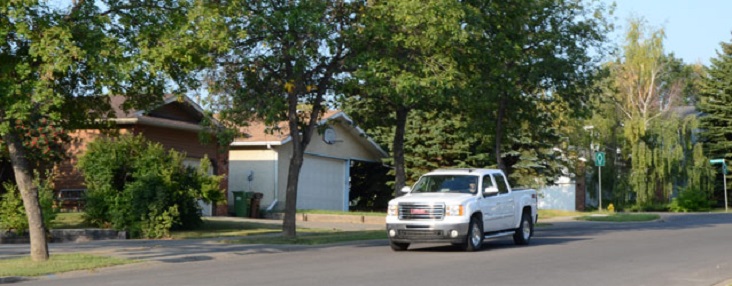
Traffic Noise
The City of St. Albert's Noise Bylaw 31/2006 applies to noises that are intermittent, unusual or unique in nature such as construction work, outdoor maintenance work, truck loading/unloading and outdoor public address systems. It defines daytime hours versus quiet hours, as well as permissible sound levels during both time periods.
Although roadway traffic is not generally intermittent, unusual or unique, the sounds generated by roadways adjacent to residential areas are recognized as an important contributor to environmental noise levels.
Environmental noise levels from roadways are commonly described in terms of 24Leq (dBA), which represents an equivalent sound level measured over a 24-hour time period that is A-weighted to account for the reduced sensitivity of average human hearing to low-frequency sounds.
In line with Noise Bylaw 31/2006, the City’s Municipal Engineering Standards (Section 3.3.1.9 – Noise Attenuation) requires the completion of a Noise Impact Assessment (NIA) in cases where an arterial roadway or railway runs through or adjacent to a proposed residential development. The NIA measures existing noise levels, estimates future noise levels, and identifies what, if any, noise attenuation measures are required to achieve a 24Leq of 65 dBA or lower.
The City has undertaken several initiatives related to traffic noise in the past five years.
City-wide Traffic Noise Study (2019)
In 2018-19, GHD Limited was retained by the City of St. Albert to conduct a City-Wide Traffic Noise Monitoring Study, that included the collection of noise data at 48 residential properties adjacent to key arterial and collector roadways in the City.
City-Wide Traffic Noise Monitoring Study (12 MB)
The study found that:
- None of the 48 locations experienced 24Leq at or above 65 dBA.
- Three locations had a measured 24Leq greater than 60 dBA but less than 65 dBA.
- 23 locations had a measured 24Leq greater than 55 dBA but less than 60 dBA.
Arterial Roadway Noise Monitoring (2022)
Building upon the findings of the City-wide Traffic Noise Monitoring Study, more detailed investigations were undertaken at select locations with a greater emphasis placed on residential locations adjacent to major arterial roadways within the City where noise levels are highest. This included the collection of noise data at 18 residential properties along St. Albert Trail, Boudreau Road, Giroux Road, Bellerose Drive, Anthony Henday Drive, Sir Winston Churchill Avenue and Hebert Road.
Noise Monitoring Locations Map
Phase 2 Traffic Noise Monitoring Study (19 MB)
The study found that:
- None of the 18 locations experienced 24Leq at or above 65 dBA ranging from 48 dBA to 59 dBA.
- Noise contributions at each monitoring location could be largely attributed to nearby roadways.
- Although the 24Leq at these locations was well below 65 dBA, some locations experienced a high number of short-term loud bursts of noise from engine exhausts and heavy trucks.
Noise Modeling
While the 24Leq threshold of 65 dBA has not been exceeded, it is recognized that road noise, including short-term burst events, can cause concern for adjacent residents. From the previous efforts, the City has prioritized three areas for further investigation, including noise modelling of the areas, quantifying the expected noise reduction from the installation of noise attenuation measures, and considering the cost/benefit of noise attenuation measures at these locations.
This includes:
- Giroux Road – Durham Avenue to Larson Avenue
- Boudreau Road/Bellerose Drive Intersection
- Boudreau Road/Campbell Road Intersection
This work is underway and anticipated for completion in 2024. More information will be shared when the reports are finalized. The findings of this modelling are intended to inform the development of updated policies. Related Pages
Last edited: July 25, 2024


